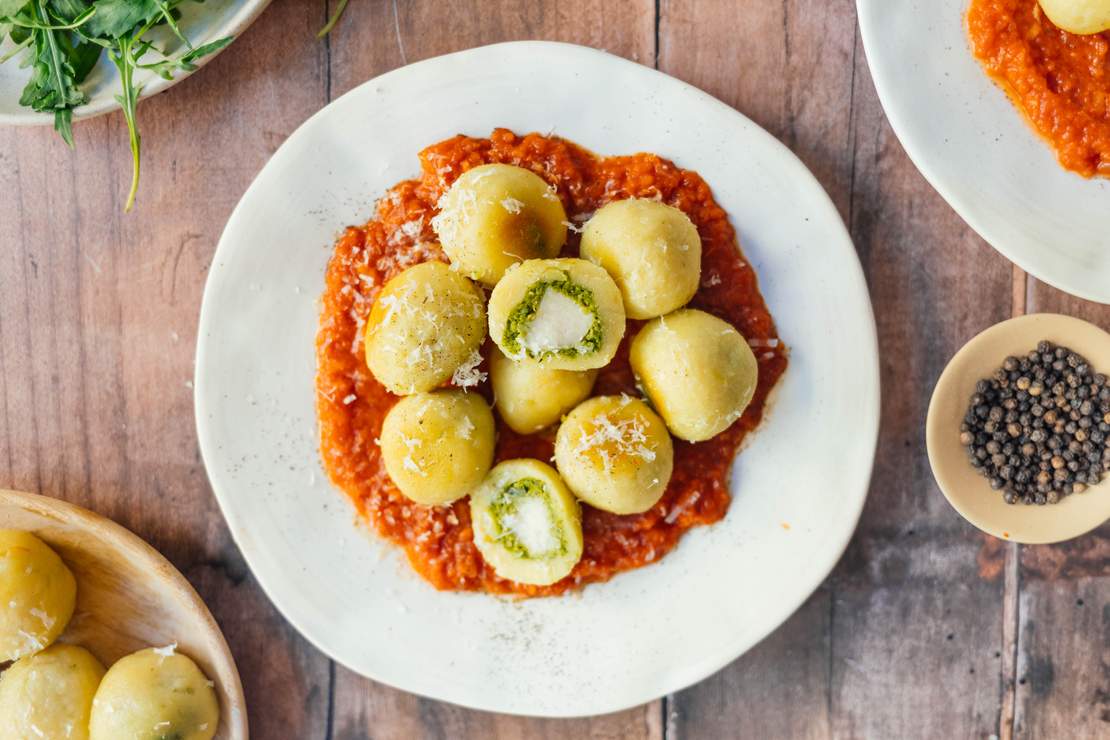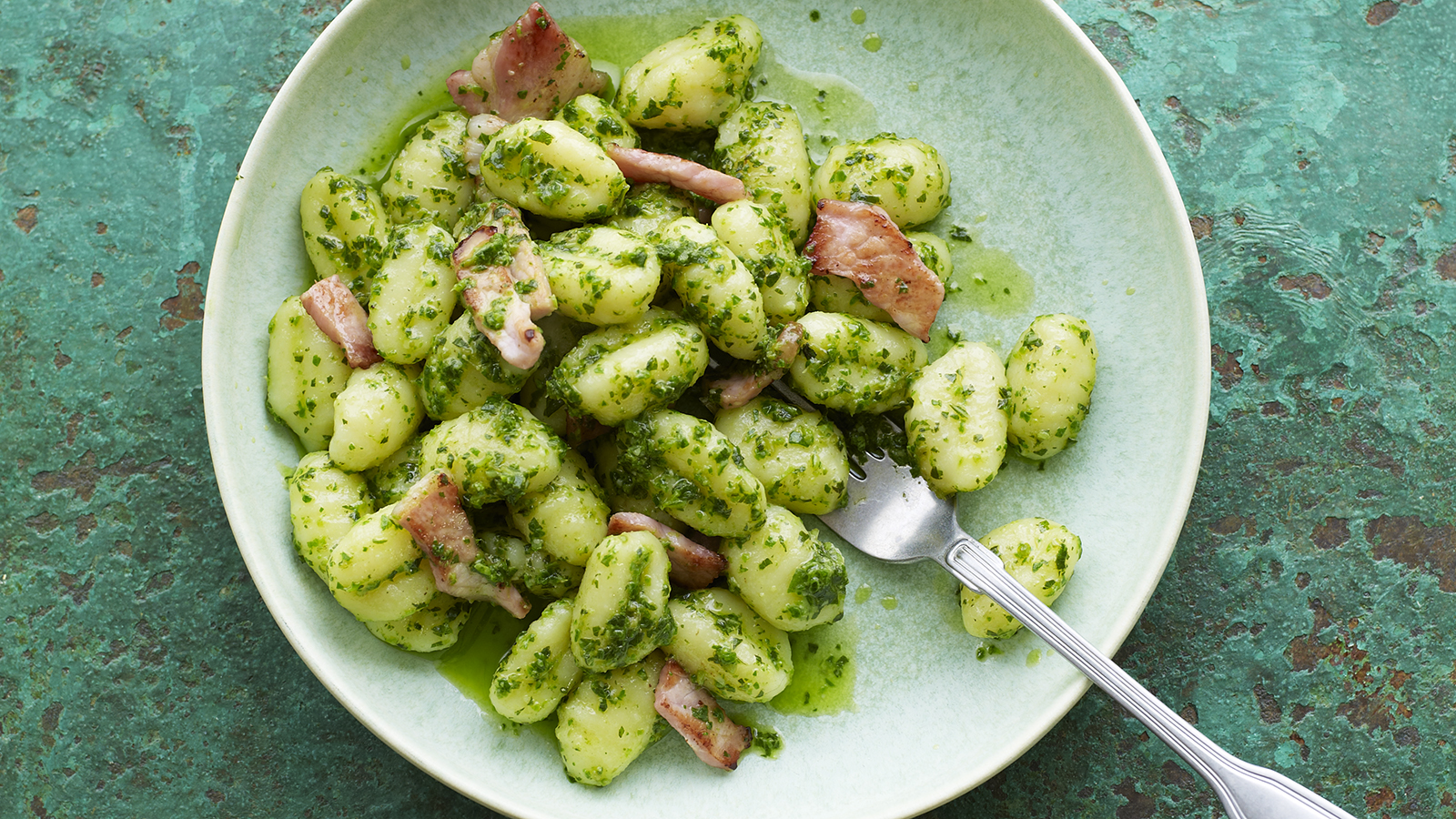Gnocchi: A Divine Celebration of Flavor and Culinary Mastery
Gnocchi, the delightful Italian dumplings, are a testament to the simplicity and elegance of Italian cuisine. Made from humble ingredients such as potatoes, flour, and eggs, gnocchi have been celebrated for centuries as a versatile and comforting dish. This article explores the rich history, meticulous preparation, various delectable variations, and the global appeal of gnocchi, demonstrating why it stands as a symbol of flavor and culinary mastery.
The History of Gnocchi: A Journey Through Time

Gnocchi’s origins can be traced back to Roman times, where similar dumplings were made using a variety of flours, including semolina and wheat. The name “gnocchi” is believed to derive from the Italian word “nocchio,” meaning a knot in wood, or “nocca,” meaning knuckle, reflecting their distinctive shape.
The introduction of the potato to Europe in the 16th century, following the Columbian Exchange, revolutionized gnocchi recipes. Potatoes, initially met with skepticism, eventually became a staple in Italian cuisine, leading to the creation of the beloved potato gnocchi we know today. Over centuries, regional variations of gnocchi developed, each with its unique twist on this classic dish.
The Art of Making Gnocchi: Techniques and Tips
Crafting perfect gnocchi requires a balance of skill and simplicity. The process, while straightforward, demands attention to detail to achieve the ideal texture and flavor.
Key Ingredients and Preparation Steps
- Selecting Potatoes: The choice of potatoes is crucial. Floury, starchy potatoes like Russets or Yukon Golds are ideal as they produce light and fluffy gnocchi. Waxy potatoes should be avoided as they can result in dense, heavy dumplings.
- Boiling and Mashing: Potatoes are boiled with their skins on to prevent them from absorbing too much water. Once cooked, they are peeled and mashed or put through a potato ricer to ensure a smooth, lump-free texture.
- Mixing the Dough: The mashed potatoes are mixed with flour and a pinch of salt. Some recipes also include an egg to help bind the dough, but this is optional. The key is to handle the dough as little as possible to keep it light and airy.
- Forming Gnocchi: The dough is rolled into ropes and cut into small pieces. Each piece is then rolled over a fork or gnocchi board to create the characteristic ridges that help sauce adhere to the dumplings.
- Cooking: Gnocchi are cooked in boiling salted water until they float to the surface, usually taking only a few minutes. They should be drained immediately and served with the chosen sauce.
Varieties of Gnocchi: Exploring Different Flavors

One of gnocchi’s greatest strengths is its versatility. From classic potato gnocchi to creative contemporary versions, the possibilities are endless.
Classic Gnocchi Varieties
- Potato Gnocchi: The most well-known type, potato gnocchi is traditionally served with simple sauces like brown butter and sage, marinara, or pesto.
- Semolina Gnocchi (Gnocchi alla Romana): Made from semolina flour, milk, and cheese, these gnocchi are baked rather than boiled. They are typically cut into discs and baked with butter and Parmesan cheese until golden.
- Ricotta Gnocchi: Lighter than potato gnocchi, ricotta gnocchi are made with fresh ricotta cheese, flour, and eggs. They have a delicate, airy texture and are often paired with light tomato or cream sauces.
Contemporary Twists on Gnocchi
- Sweet Potato Gnocchi: A nutritious and flavorful alternative to traditional potato gnocchi, sweet potato gnocchi have a subtle sweetness that pairs well with savory sauces like sage brown butter or garlic and herb.
- Pumpkin Gnocchi: Perfect for autumn, pumpkin gnocchi have a beautiful orange hue and a slightly sweet, earthy flavor. They are delicious with a butter and sage sauce or a light cream sauce.
- Spinach and Ricotta Gnocchi: Combining spinach and ricotta cheese, these green gnocchi are packed with flavor and nutrients. They pair wonderfully with tomato-based or creamy garlic sauces.
The Elegance of Gnocchi: A Dish for Every Occasion

Gnocchi’s versatility and elegance make it suitable for various occasions, from casual family dinners to sophisticated gatherings.
Gnocchi in Fine Dining
In fine dining establishments, gnocchi is often elevated with gourmet ingredients and artistic presentation. Chefs may incorporate truffles, exotic mushrooms, or high-quality cheeses to create luxurious gnocchi dishes. The presentation is meticulous, turning a humble dish into a culinary masterpiece.
Gnocchi at Home: Comfort and Creativity
Despite its presence in high-end restaurants, gnocchi is also a comforting and accessible dish to make at home. Homemade gnocchi allows for endless creativity, as cooks can experiment with different ingredients and sauces. The process of making gnocchi can be a therapeutic and enjoyable activity, bringing families together in the kitchen.
Pairing Gnocchi: Complementing Flavors
Pairing gnocchi with the right beverages and side dishes enhances the overall dining experience. Here are some suggestions:
Wine Pairings
- White Wines: Light, crisp white wines like Pinot Grigio or Sauvignon Blanc complement the delicate flavors of ricotta or vegetable-based gnocchi.
- Red Wines: Heavier potato or meat-filled gnocchi pair well with medium-bodied red wines like Chianti or Merlot.
Side Dishes
- Salads: A fresh, crisp salad with a light vinaigrette can balance the richness of gnocchi, providing a refreshing contrast.
- Bread: Crusty Italian bread is perfect for soaking up any leftover sauce, making it a perfect accompaniment to gnocchi.
- Vegetables: Roasted or steamed vegetables add color, texture, and additional flavors to the meal.
Gnocchi: A Global Phenomenon

While gnocchi is quintessentially Italian, it has been embraced worldwide, with each culture adding its unique touch.
Gnocchi in Modern Cuisine
In contemporary cuisine, gnocchi has been adapted to suit various dietary preferences. Gluten-free and vegan gnocchi options are now widely available, ensuring everyone can enjoy this classic dish.
Cultural Fusion
Fusion cuisine has given rise to innovative gnocchi dishes that blend flavors from different culinary traditions. For example, an Asian-inspired gnocchi might feature fillings like pork and ginger, while a Mexican twist could include ingredients like black beans and corn.
Conclusion: Gnocchi’s Timeless Appeal
Gnocchi remains a beloved dish for many reasons. Its versatility, ability to adapt to various flavors and ingredients, and its elegance make it a favorite in both home kitchens and fine dining establishments. The process of jpslot making gnocchi, though requiring time and effort, is a rewarding experience that results in a truly delightful gourmet dish. Whether enjoyed as a comforting homemade meal or a sophisticated restaurant offering, gnocchi’s charm and culinary excellence continue to captivate food lovers around the world.
In conclusion, gnocchi is more than just a dish; it is a testament to the beauty of culinary creativity and tradition. Its enduring appeal lies in its ability to bring joy and satisfaction with every bite. So, the next time you savor a plate of gnocchi, take a moment to appreciate the craftsmanship and passion that go into creating this divine celebration of flavor and culinary mastery.
